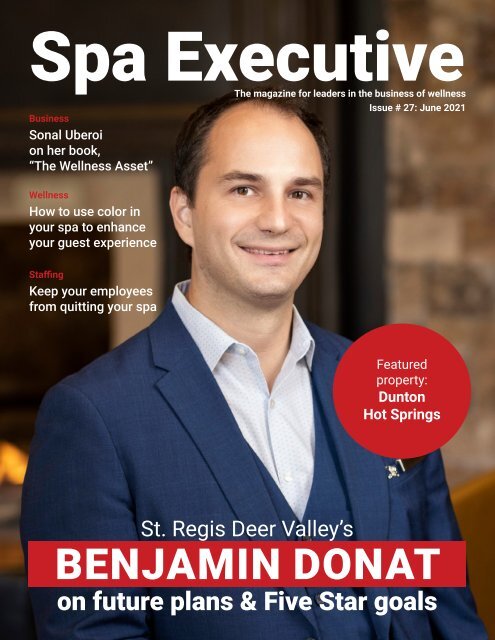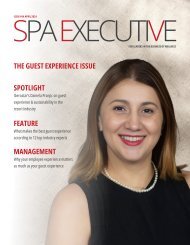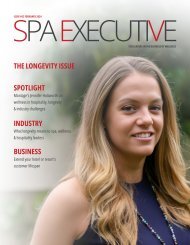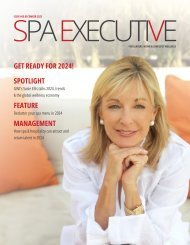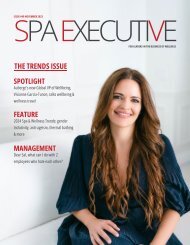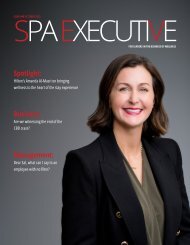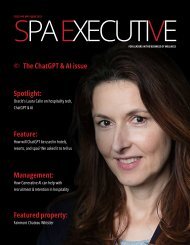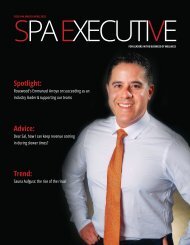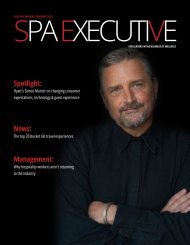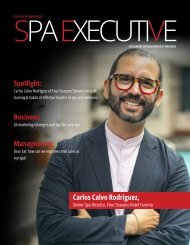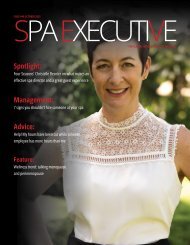Spa Executive June 2021
Create successful ePaper yourself
Turn your PDF publications into a flip-book with our unique Google optimized e-Paper software.
<strong>Spa</strong> <strong>Executive</strong><br />
The magazine for leaders in the business of wellness<br />
Business<br />
Sonal Uberoi<br />
on her book,<br />
“The Wellness Asset”<br />
Issue # 27: <strong>June</strong> <strong>2021</strong><br />
Wellness<br />
How to use color in<br />
your spa to enhance<br />
your guest experience<br />
Staffing<br />
Keep your employees<br />
from quitting your spa<br />
Featured<br />
property:<br />
Dunton<br />
Hot Springs<br />
St. Regis Deer Valley’s<br />
BENJAMIN DONAT<br />
on future plans & Five Star goals
In this month’s issue:<br />
3<br />
7<br />
9<br />
13<br />
15<br />
20<br />
How to use color in your spa to<br />
enhance your guest experience<br />
Keep your employees from<br />
quitting your spa<br />
St. Regis Deer Valley’s<br />
Benjamin Donat<br />
on future plans & Five Star goals<br />
How to to use software<br />
to increase spa occupancy<br />
Turning Stone Resort & Casino:<br />
happier staff, increased efficiency,<br />
and a four-star rating:<br />
the benefits of an operations upgrade<br />
Featured property: Dunton Hot Springs<br />
25<br />
Sonal Uberoi on her book,<br />
“The Wellness Asset”<br />
29<br />
5 trends shaking up the<br />
spa industry
Letter from Publisher<br />
Dear readers,<br />
In this month’s issue, rising star Benjamin Donat, <strong>Spa</strong> Director at the St. Regis,<br />
Deer Valley, talks about guest experience, how the spa industry is changing,<br />
and reaching for the spa’s fifth Forbes Star.<br />
He also touches on one the topic of staffing, which we all know is one of<br />
the biggest challenges (if not the biggest challenge) spas and hospitality<br />
businesses are facing globally, and points to one of the developments to<br />
come out of the COVID-19 pandemic as a possible partial solution. That<br />
development is touchless therapies and treatment options.<br />
Donat said, “It’s exciting that, because there were so many issues in the<br />
last year, people got creative to find solutions. I’ve seen some great ideas,<br />
including touchless therapies and treatment options which can help us<br />
provide the services guests need and also solve the staffing problem a little<br />
bit. I love the idea of technology to help us while not eliminating the personal<br />
touch.”<br />
Read Donat’s interview here: St. Regis Deer Valley’s Benjamin Donat on<br />
future plans & Five Star goals.<br />
In a happy bit of synchronicity, his comments echo themes threaded<br />
throughout this issue.<br />
In Keep your employees from quitting your spa we have pulled insight from<br />
Verena Lasvigne-Fox, Senior <strong>Spa</strong> Director, Four Seasons Hotels and Resorts,<br />
on how best to reduce employee turnover rates. And that article leads to a<br />
downloadable resource of more in-depth commentary from a list of industry<br />
leaders, including ISPA President Lynne McNees, Daisy Tepper, <strong>Spa</strong> Director<br />
at The Post Oak Hotel at Uptown Houston, and others.<br />
And we tackle the often-expressed fear that technology will erode the human<br />
touch in How technology can add a personal touch in your spa.<br />
This month, we also feature our interview with global wellness expert, Sonal<br />
Oberoi, about her new book The Wellness Asset and take a look into the<br />
breathtaking Dunton Hot Springs, a ghost town turned luxury resort on a<br />
lithium-rich hot spring.<br />
And, in our executive column by Book4Time’s Marketing Manager, Emily<br />
Moxley, we look at 5 trends shaking up the spa industry.<br />
I hope you enjoy reading this month’s articles in <strong>Spa</strong> <strong>Executive</strong> and they<br />
provide valuable information to help you achieve success.<br />
About<br />
<strong>Spa</strong> <strong>Executive</strong>:<br />
<strong>Spa</strong> <strong>Executive</strong> is<br />
Book4Time’s magazine<br />
for leaders in the business<br />
of wellness. News, views,<br />
and interviews for those<br />
who want to attract top<br />
talent, increase customer<br />
retention, and offer the best<br />
possible guest experience.<br />
The<br />
<strong>Spa</strong> <strong>Executive</strong><br />
Team<br />
Publisher<br />
Roger Sholanki<br />
Creative Director<br />
Nima Chadha<br />
Creative Coordinator<br />
Emily Moxley<br />
Editor<br />
Elizabeth Bromstein<br />
Designer<br />
Cecilia Chavira Valle<br />
Roger Sholanki,<br />
CEO<br />
Book4Time
Color may impact emotions and<br />
even behavior. Here’s how to use<br />
color in your spa to enhance your<br />
guest experience.<br />
HOW TO USE COLOR<br />
IN YOUR SPA TO ENHANCE<br />
YOUR GUEST EXPERIENCE<br />
Just like the music and sounds guests experience<br />
in your spa or wellness business environment,<br />
color may have a dramatic impact on mood and<br />
emotion, and even influence customer behavior.<br />
Studies have found that green may increase<br />
concentration and task accuracy and also that<br />
workers in white and predominantly blue-green<br />
offices reported higher perceived job performance<br />
and satisfaction than those in predominantly<br />
red offices.<br />
Red, meanwhile, has been correlated with impaired<br />
performance on achievement of certain tasks,<br />
which researchers suggested is because red is<br />
associated with the danger of failure and evokes<br />
avoidance motivation. However, with sports, red<br />
outfits have been associated with an advantage<br />
over blue outfits.<br />
This doesn’t mean that effects of color are<br />
universal. Multiple factors may influence how a<br />
person feels when exposed to a certain color, such<br />
as cultural or personal association. As pointed out<br />
here by Cameron Chapman, author of the book<br />
Colour for Web Design, “If a person’s favorite stuffed<br />
animal as a child was blue, for example, then they<br />
may have a preference for blue throughout their<br />
life. Or, at the opposite end of the spectrum, if<br />
they were hit by a blue car as a child, they might<br />
have a strong negative emotional reaction to the<br />
color blue.”<br />
There are, however, universal human experiences<br />
that allow us to guess how people are going to<br />
react to some colors. Green and blue, for example,<br />
are associated with nature and calm, like plants,<br />
grass, forests, the sky, and water.<br />
Chapman also notes the following associations:<br />
<strong>June</strong> <strong>2021</strong> Issue • p. 3
Red is associated with<br />
passion, love, lust, rage, and<br />
warnings. She states, “Red<br />
can have a physiological<br />
impact on people, too,<br />
including raising respiration<br />
and heart rate.”<br />
Orange is energetic,<br />
positive, and also<br />
connected with change<br />
due to its association<br />
with autumn leaves and<br />
seasonal transitions<br />
and, to a lesser<br />
degree, warnings.<br />
Yellow is considered the<br />
happiest color and is<br />
closely associated with<br />
sunshine and hope,<br />
though it can also be<br />
linked with caution<br />
and cowardice.<br />
When it comes to your spa environment,<br />
you might consider different colors for<br />
different areas, depending on the emotions<br />
and behaviors each is designed to evoke.<br />
You want your treatment and service areas<br />
to create feelings of calm and relaxation.<br />
You want the same of your staff break room,<br />
but you probably also want that area to feel<br />
energizing and rejuvenating, while you may<br />
want your retail areas to suggest a desire<br />
to purchase. Can colors help create the<br />
right atmosphere? We spoke with Leatrice<br />
Eiseman, a color specialist, head of the<br />
Eiseman Center for Color Information and<br />
Training and executive director of the Pantone<br />
Color Institute. Eiseman, also known as<br />
“the international color guru,” offered some<br />
insight on how to proceed when choosing<br />
colors for different areas of your spa.<br />
<strong>June</strong> <strong>2021</strong> Issue • p. 4
Colors for your treatment rooms<br />
“Color temperature is something that people are<br />
very aware of, even though it might be subliminal<br />
and not an obvious effect,” Eiseman said. “A<br />
natural selection for a spa could come from one of<br />
two directions. One would be the so-called cooler<br />
tones but with a little bit of warmth, blues and blue<br />
greens, like water and the sky on a beautiful day.<br />
These are colors that the human mind attaches<br />
to quiet, soft repose. Avoid electric blue or blues<br />
that lean towards the purple side, which is getting<br />
a bit too warm, though you could do a lavender.<br />
You want it to be welcoming and quieting, and to<br />
use colors that psychologically and emotionally<br />
affect people in a way that makes them feel sort of<br />
tranquilized. It can be a lighter tone or something<br />
more aqua, anything that has that watery or sky<br />
feeling that says it’s going to be a beautiful day.”<br />
More heated colors, like yellows, oranges, or reds<br />
will have the opposite effect of what you want,<br />
she said.<br />
“The other direction one could take is to use the<br />
pastel range in somewhat warmer tones, because<br />
they have a nurturing quality. You could do a very<br />
light peachy field. Pinks that lean to the warm<br />
side or the cool side, either one, are also quieting.<br />
Obviously, a lighter pastel range has a much<br />
quieter feeling than the brighter areas of color,<br />
provided they are kept soft and subtle and don’t<br />
start to heat up too much.”
Colors for your retail space<br />
Eiseman said, “Retail is where you want to build<br />
up excitement. You want to make it very different<br />
from the rest of the experience. Red is still too<br />
aggressive. The purple family has quite a range,<br />
and purples can have an excitement attached to<br />
them because purple is a complex color made up<br />
of both red and blue, the best of all worlds. With<br />
high-end products I’d go into the purples that are<br />
a little deeper, like aubergine. That would make<br />
it very different from the other area and have a<br />
classy elegance attached to it that would be a<br />
great background for product.<br />
Eiseman suggests that “one colored wall with<br />
product against it can be very effective, rather<br />
than all four purple walls, which would feel like<br />
it was closing in. Or it can be purple accents,<br />
like shelving.”<br />
Another suggestion is the use of metallic colors<br />
in retail spaces, or something in the purple family<br />
with a metallic finish. Metallic colors, Eiseman<br />
said, add to the perceived value of the product.<br />
Colors for your staff rooms<br />
All of this can work even if the waiting room is<br />
the same as the retail room, she said, “because<br />
when guests go into the spa area, they are really<br />
hit with the relaxation because of the difference in<br />
color atmosphere.”<br />
Eiseman said that, when it comes to staff<br />
break rooms, you want your team to feel<br />
energized, but you don’t want it to be aggressive<br />
because you also want people to feel relaxed<br />
and comfortable.<br />
“You could do something more vital in either cool<br />
or warm tones, such as greens with more vitality.<br />
These are refreshing, which is a good word for<br />
anybody who is going to be working with others.<br />
You want the color to be a little more saturated and<br />
to have more brightness. I would avoid red. Red is<br />
the most exciting color but can be very aggressive<br />
and we don’t want that in a break room. I wouldn’t<br />
do the soft blue greens that I recommended for<br />
the spa, but something with a little bit more yellow<br />
base, to add a bit more excitement.”
Staffing is a big challenge in spa<br />
and wellness. Here are some tips<br />
on how to keep your employees<br />
from quitting your spa.<br />
KEEP YOUR EMPLOYEES<br />
FROM QUITTING YOUR SPA<br />
The spa and wellness industry has been facing<br />
staffing challenges for well over a decade and<br />
today, “staffing” is the most common response<br />
from industry leaders whenever we at Book4Time<br />
and <strong>Spa</strong> <strong>Executive</strong> ask them what challenges they<br />
are facing.<br />
<strong>Spa</strong>s and wellness businesses can’t find the<br />
qualified service providers and managers they<br />
need, and turnover is huge. Meanwhile, the<br />
wellness industry continues to grow.<br />
We recently spoke with some industry leaders for<br />
a special Book4Time report to ask what they think<br />
spa and wellness can do to attract and retain talent<br />
– and maybe solve its ongoing staffing problem<br />
once and for all. Among the people we interviewed<br />
for the paper is Verena Lasvigne-Fox, Senior <strong>Spa</strong><br />
Director, Four Seasons Hotels and Resorts.<br />
Lasvigne-Fox told us, “At Four Seasons we believe<br />
that our employees are the heart and soul of what<br />
makes our company succeed and that is why we will<br />
maintain our leading position in the future. When<br />
hiring, we select carefully and don’t compromise.<br />
At Four Seasons we conduct behavior-based<br />
job interviews as opposed to technical-based<br />
interviews because we want to know who the<br />
employee is and make sure that employee values<br />
and personality are in keeping with our company<br />
values. Finding “the best” candidate is often easier<br />
said than done.<br />
“Our company spends a lot of time thinking about<br />
how we need to provide this future talent with an<br />
environment where they feel comfortable and feel<br />
they belong, that they have an opportunity to grow<br />
and hopefully have a career with us. Companies<br />
need to develop the ability to attract talent as<br />
this is critical to the future of our industry, and<br />
ultimately any industry. Attracting young talent is<br />
a huge focus today for us as a company. Once you<br />
have hired talented candidates, invest in these<br />
employees, offer them a career, and inspire them.<br />
They will stay longer with your company and you<br />
have lower turnover rates.”<br />
This is good advice. Let’s break down what we<br />
think it means to invest in your employees, offer<br />
them a career, and inspire them.<br />
<strong>June</strong> <strong>2021</strong> Issue • p. 7
Investing in your employees<br />
Investing in your employees means different<br />
things to different people. Some things that it<br />
can mean include:<br />
Offering a competitive wage. It’s important<br />
to remember that you get what you pay for<br />
and if you want top talent you should be<br />
prepared to pay top talent. Investing in your<br />
team members can also mean devoting<br />
time and energy to proper onboarding<br />
and training.<br />
Sharing your mission, values, and business<br />
goals with the team and ensuring that they<br />
feel connected to these elements and know<br />
they are an integral part of your success.<br />
When employees understand why their<br />
contribution matters, they are more invested<br />
in that contribution.<br />
Offering them a career<br />
A common complaint in the spa industry is a lack<br />
of qualified managers. Leaders can create those<br />
managers, if they’re willing to put in the effort.<br />
Being offered a career over just a “job” makes<br />
all the difference to an individual’s sense of self<br />
worth and overall commitment to a role. It’s the<br />
difference between going through the day-to-day<br />
motions with nothing on the horizon and a feeling<br />
of forward momentum with the knowledge that<br />
someone believes in you, the value you bring, and<br />
in your future.<br />
Inspire them<br />
What can leaders do to inspire their teams?<br />
Sharing mission, values, and goals is one thing.<br />
Leading by example is another. Being an inspiring<br />
leader means setting a standard of behavior,<br />
which begins with being kind and treating people<br />
well. When we treat people well, they treat others,<br />
including fellow employees and guests, well.<br />
Other ways to set a standard of behavior include<br />
behaving with honesty and integrity.<br />
And according to this HBR article, there is one trait<br />
that matters more than any other when it comes<br />
to being an inspirational leader: centeredness.<br />
The article states: “This is a state of mindfulness<br />
that enables leaders to remain calm under stress,<br />
empathize, listen deeply, and remain present.”<br />
The more centered we are, the better leaders we<br />
will be.<br />
Taking the time to get to know your<br />
employees and set expectations. When<br />
people know what is expected of them<br />
they’re more likely to achieve it and these<br />
achievements build confidence and make<br />
everyone happy – and when everyone is<br />
happy, people are less likely to quit.<br />
This is just one piece of insight from our indepth<br />
report. To read more from industry leaders,<br />
including Karla Herrasti, Corporate Director of <strong>Spa</strong><br />
in Latin America for RCD Hotels, Nigel Franklyn, The<br />
<strong>Spa</strong> Whisperer, Lynne McNees, President of ISPA<br />
(International SPA Association), and Daisy Tepper,<br />
<strong>Spa</strong> Director at The Post Oak Hotel at Uptown<br />
Houston, click to download the full report.<br />
<strong>June</strong> <strong>2021</strong> Issue • p. 8
Benjamin Donat, <strong>Spa</strong> Director at<br />
Park City, Utah’s St. Regis Deer<br />
Valley talks with <strong>Spa</strong> <strong>Executive</strong><br />
about future plans and reaching<br />
for that Fifth Forbes Star.<br />
ST. REGIS DEER VALLEY’S<br />
BENJAMIN DONAT ON FUTURE<br />
PLANS & FIVE STAR GOALS<br />
Park City, Utah’s St. Regis Deer Valley is one of the<br />
world’s most luxurious mountain resorts.<br />
Featuring design that echoes the beauty of<br />
its location amidst the picturesque Wasatch<br />
Mountains, in winter, the resort offers convenient<br />
ski-in/ski-out access with a private ski valet, and<br />
in warmer months, guests enjoy mountain biking<br />
and hiking.<br />
In July, 2020, Benjamin Donat took the reins as <strong>Spa</strong><br />
Director at the resort’s Remède <strong>Spa</strong>, an incredible<br />
14,000-square-foot facility with 11 sophisticated<br />
treatment rooms and Four Forbes Stars. Remède’s<br />
certified spa therapists offer a full suite of body<br />
treatments combining ancient healing arts with<br />
modern techniques and high-quality products in a<br />
soothing atmosphere dedicated to relaxation and<br />
tranquility, enhanced by water-inspired amenities.<br />
In the few months he’s been on the job, Donat<br />
has been setting a high bar and working to<br />
create an exceptional experience for every guest,<br />
providing superlative treatments and successfully<br />
incorporating a vision of the increasing importance<br />
of self-care.<br />
We spoke with Mr. Donat about his plans for the<br />
Remède <strong>Spa</strong> and reaching for that 5th Forbes Star.<br />
<strong>June</strong> <strong>2021</strong> Issue • p. 9
Talk about your spa at the St. Regis Deer<br />
Valley and some of the things that make<br />
it unique.<br />
We are an 11-room spa in the mountains and<br />
our experience changes with the seasons. In the<br />
winter, we are super busy because of skiing and,<br />
in the summer, there is amazing mountain biking<br />
and hiking.<br />
Our staff has to be very well versed in adjusting<br />
to the sport that the guests are doing. We all have<br />
to be very aware of our guests’ needs. We offer<br />
morning yoga on the weekends for our guests to<br />
start the day on a healthy note, maybe make them<br />
get up a little bit early and do something for body<br />
and mind, and then start the day fresh with a nice<br />
breakfast or a visit to the spa.<br />
Tell us about your career background.<br />
I’m from Germany. My background is as a sports<br />
scientist and I moved into hospitality. My first job in<br />
the industry was at the Hotel Erbprinz, in Germany,<br />
a long-time luxury establishment that opened in<br />
1788. That’s how I learned old-school luxury and<br />
how to take care of guests.<br />
I moved to the United States and worked for<br />
MGM Grand and then ARIA Resort & Casino. I<br />
had to reinvent myself a bit in the US and learn to<br />
understand the American way of looking at spa.<br />
In Europe, there is more of a focus on the amenities,<br />
rather than the treatment, to give the guests<br />
reasons to stay all day or just come for a spa day<br />
without even booking a treatment. In America<br />
the treatment is the focus, and the locker room<br />
can sometimes be an afterthought or regarded<br />
as not as important. Though I do see a bit of a<br />
shift here towards the European way lately. I think<br />
my experience with the European way helped the<br />
ARIA, in small parts, to achieve its Forbes Five-<br />
Star rating.<br />
I then worked for Choctaw in Oklahoma and the<br />
Ritz-Carlton New Orleans. Now I have the chance<br />
to prove myself at the St. Regis.<br />
We’re currently fighting for our Fifth Forbes star.<br />
If we become a Five-Star spa we will be the first<br />
Five-<strong>Spa</strong> department in the hotel, so that would be<br />
a big achievement for my team. We are just trying<br />
to be better every day.<br />
What changes or extra efforts are you<br />
making for that?<br />
I’ve gone through our past Forbes reviews to see<br />
what opportunities are in there for improvement.<br />
We’re trying to upgrade and tweak everything a<br />
little bit, like ensuring that the linen is luxurious.<br />
We have new, lighter weight towels that will save<br />
thousands of gallons of water during washing but<br />
are higher luxury than our old towels.<br />
Also, how do we greet the guests and how can we<br />
elevate that guest experience? We start every <strong>Spa</strong><br />
visit with a Wellness Shot and end every treatment<br />
with a Beauty Shot.<br />
We’re working on keeping track of guest<br />
information for the massage therapists. If the<br />
guest has had a birthday, for example, we can<br />
greet that person with a ‘happy birthday,’ and say<br />
‘we have something ready for you to check out.’<br />
We are focusing on the little things.<br />
<strong>June</strong> <strong>2021</strong> Issue • p. 10
I am also working with my vendor partners and<br />
asking how they can help me elevate either their<br />
products or our services. Ten brains think better<br />
than one brain. It’s not all me. It’s working with my<br />
staff and my partners.<br />
Have you noticed a recent increase in<br />
demand for wellness and a shift in guest<br />
expectations?<br />
The need for wellness and for people to get out,<br />
relieve stress, and do something for themselves is<br />
more prominent now that people have been home<br />
more. Guests are coming in with so much baggage<br />
on their shoulders now. Our goal is to release a<br />
little bit of that baggage so they can walk a little<br />
bit more freely and hopefully make their day a little<br />
bit better.<br />
Then there’s this issue of being conscious of<br />
germs while also wanting to be touched. The spa<br />
treatment offers the endorphin release and stress<br />
reduction that guests are longing for, but people<br />
need reassurance that our areas are clean and<br />
sanitized, so they can actually connect with us and<br />
feel the relaxation. This is a balancing act I think<br />
many spas are having to perform.<br />
What challenges do you think the industry<br />
will face in the foreseeable future?<br />
The staffing challenge has been and will be a big<br />
one. I have been understaffed through the season<br />
and it’s hard to find qualified candidates. This<br />
affects both the guests and the existing team;<br />
guests because sometimes they need a wellness<br />
or spa experience, and we can’t provide it at the<br />
time they want because we’re overbooked, and<br />
staff because I have to be careful not to overwork<br />
them and cause burnout. We’re in Park City, in<br />
the mountains, so as long as it snows and there<br />
is skiing we will have guests. We’ll always have<br />
guests. My major concern in staffing. That’s one<br />
of my biggest challenges.
What industry developments are you<br />
excited about?<br />
It’s exciting that, because there were so many<br />
issues in the last year, people got creative to find<br />
solutions. I’ve seen some great ideas, including<br />
touchless therapies and treatment options which<br />
can help us provide the services guests need and<br />
also solve the staffing problem a little bit. I love the<br />
idea of technology to help us while not eliminating<br />
the personal touch.<br />
My staff has also come up with their own great<br />
ideas to enhance our experience for the guests.<br />
I’m excited that people are being so creative.<br />
What makes an excellent<br />
guest experience?<br />
Recognition is a big part of that, knowing the<br />
guest and what they want, so we can personalize<br />
the service. We don’t do a 50-minute massage<br />
protocol because we have to, but to take care of<br />
the guest in front of us. Every massage is different,<br />
depending on who you’re offering it to. Six different<br />
people will book the same service and every one<br />
of them will have a different experience. When the<br />
guest walks out and says “that was the greatest<br />
massage I’ve ever had,” then I’m happy.<br />
<strong>June</strong> <strong>2021</strong> Issue • p. 12
Occupancy is one of your most important KPIs. Your spa occupancy tells you how close you are to<br />
operating at full capacity and can include measurements from your total treatment beds, treatment<br />
rooms, and amenities (more on this from Trent Munday here). Obviously, your occupancy is directly<br />
correlated to your revenue and ensuring that you’re operating at optimal occupancy is essential.<br />
Software can help.<br />
Here are six ways to use software to increase spa occupancy.<br />
Your occupancy is one of<br />
your most important KPIs.<br />
Here’s how to use software<br />
to increase spa occupancy<br />
and boost revenue.<br />
HOW TO TO USE SOFTWARE TO<br />
INCREASE SPA OCCUPANCY<br />
1. Get savvy with yield management<br />
Yield management is one of the most effective<br />
systems used in hospitality to maximize occupancy<br />
and revenue and it will help you increase spa<br />
occupancy. Yield management is a dynamic<br />
pricing strategy used with limited resources like<br />
seats on an airplane or hotel rooms – or spa<br />
treatments and amenities. The system is based<br />
on understanding, anticipating, and influencing<br />
consumer behavior which is itself influenced by<br />
factors like seasons, time of day, holidays, etc.<br />
When demand is high, prices go up, when demand<br />
is low, prices go down. A good software system<br />
can maximize peak period utilization and drive<br />
traffic during slower periods.<br />
2. Focus on repeat customers<br />
It’s more expensive to attract a new customer<br />
than it is to retain an existing one. It’s said that<br />
increasing customer retention just five percent can<br />
increase a company’s profitability by an average<br />
of 75%, and that 80% of future profits come from<br />
20% of current customers. Once a guest has<br />
visited your business, take the time to nurture<br />
that relationship. Log customer information and<br />
preferences, analyze customer purchase trends,<br />
collect feedback, and share it all with your team<br />
so they can create one-of-a-kind personalized<br />
experiences and bring them back into your<br />
space. A software’s guest experience & CRM<br />
functionalities, like Central Guest Profiling, makes<br />
it all simple and intuitive.<br />
<strong>June</strong> <strong>2021</strong> Issue • p. 13
3. Identify your customers<br />
Another application for guest experience &<br />
CRM functionalities like Central Guest Profiling.<br />
Knowing who is coming to your spa will help you<br />
focus your marketing on these people, speak<br />
directly to them, and offer what they want. Your<br />
market is not everyone, it is a specific group of<br />
people. Look at the guest information collected<br />
by your spa management software system, like<br />
demographics and purchase history, and ask<br />
yourself: who are my customers? How do they<br />
want to be communicated with and through<br />
which channels? What do they want and how<br />
can I give it to them? Then focus your marketing<br />
efforts accordingly.<br />
5. Create friends & family<br />
packages and promotions<br />
Why stop at couples massages? Encourage your<br />
guests to bring someone with them by promoting<br />
a mother daughter offering, family time, group<br />
package, or something different. This can be<br />
particularly enticing in areas where physical<br />
distancing is still in effect, because people can<br />
have areas of the spa all to themselves. Software<br />
functionalities allow you to encourage return visits<br />
with loyalty points, client referral discounts, and<br />
promotions. Build your own incentive program and<br />
customize it to your brand.<br />
4. Use gift cards<br />
Gift cards are among your greatest tools for<br />
attracting new clients. One survey found that<br />
40% of respondents said that receiving a gift<br />
card prompted them to visit a store they would<br />
not otherwise have visited for the first time. “they<br />
wouldn’t even have visited if they hadn’t received<br />
the card” Once they make that initial visit you have<br />
the chance to turn them into returning customers.<br />
Remember: getting people in the door the first time<br />
is more difficult and more expensive than bringing<br />
them back. More than half of respondents also<br />
said receiving a gift card prompted them to visit<br />
a store more frequently. Gift cards marketed to<br />
your existing customer base can also encourage<br />
referrals. Software solutions like Book4Time<br />
allow you to create and sell your own gift cards to<br />
increase brand recognition and market penetration<br />
and manage your gift card program across all<br />
locations with a central system.<br />
6. Consider a membership program<br />
Memberships are the norm in fitness, and now more<br />
spas and wellness businesses are seeing the value<br />
of membership programs. Wellness memberships<br />
can include access to amenities, like pools and<br />
saunas, but can also go towards services like<br />
facials, body treatments, and massage. Instead of<br />
charging per service, a set rate per month or year<br />
buys a certain number of services and/or access<br />
to amenities. Memberships are a great way to<br />
encourage repeat visits and nurture relationships,<br />
and can also create a steady revenue stream in<br />
slower times. A centralized membership program<br />
helps increase guest retention through member<br />
discounts, exclusive services, or monthly credits<br />
that can be redeemed at your facility.<br />
Book4Time’s cloud-based system can help manage your yield management, guest experience and CRM,<br />
packages, promotions, loyalty and membership programs, and more to increase spa occupancy. Learn<br />
more at Book4Time.com or schedule a demo.<br />
<strong>June</strong> <strong>2021</strong> Issue • p. 14
A cloud-based booking platform<br />
gives providers flexibility, and<br />
eliminates the need to<br />
maintain servers.<br />
HAPPIER STAFF,<br />
INCREASED EFFICIENCY,<br />
AND A FOUR-STAR RATING:<br />
THE BENEFITS OF AN<br />
OPERATIONS UPGRADE<br />
When a guest steps into a spa, they expect peace,<br />
serenity, tranquility, and relaxation. Everything<br />
should feel effortless and enjoyable. On the back<br />
end, however, spa operations can be anything<br />
but serene.<br />
I have a lot of experience with spa operations,<br />
having worked in this business for 22 years. Today,<br />
I’m the director of spa operations at Turning Stone<br />
Resort and Casino in central New York. We have<br />
two spas here at Turning Stone: our day spa and<br />
salon, Ahsi, and our resort spa, Ska:ná. I oversee<br />
everything from menus to staff, facilities to the<br />
guest experience—anything that encompasses<br />
the spa experience at our resort. I joined Turning<br />
Stone with a very clear three-point mandate: make<br />
the spas profitable, improve staff satisfaction, and<br />
get us rated in Forbes Travel Guide.<br />
Shane Bird,<br />
<strong>Spa</strong> Director,<br />
Turning Stone Casino Resort<br />
An experience marred by frustration and<br />
inefficiency<br />
I had my work cut out for me. Back in 2013,<br />
there were times that the spa lobbies would be<br />
completely empty. Part of that stemmed from a<br />
lack of brand presence and brand awareness,<br />
everything from how the spas were marketed to<br />
how the phone systems worked. There was one<br />
phone number for Ahsi and another for Ska:ná,<br />
and often guests would call one, not knowing<br />
the other existed. The number for Ska:ná was<br />
only publicized in one guest book at the all-suite<br />
hotel and nowhere else. Right out of the gate,<br />
<strong>June</strong> <strong>2021</strong> Issue • p. 15
I combined phone systems to a central number,<br />
where guests could choose whether they wanted<br />
to book a service at Ahsi or Ska:ná.<br />
Staff makes or breaks the guest experience at a<br />
spa, and there was a lot of discontent among our<br />
staff. They felt they didn’t have a voice. So another<br />
one of my top priorities was to engage the staff,<br />
listen to their needs, and address their pain points.<br />
One of those pain points was the laborious<br />
software that we used. It wasn’t integrated with<br />
anything else; there was a separate application<br />
to book services, another system for POS, and<br />
yet another for payroll. Doing payroll itself was<br />
monstrous. It used to take me six hours just to<br />
reconcile providers’ commissions, and I had to<br />
do that every week. It was also frustrating for our<br />
finance or IT departments; a server-based platform<br />
like the one we used meant the IT staff had to<br />
constantly monitor, maintain, and troubleshoot onpremise<br />
servers.<br />
The guests also felt the impact of our inefficient<br />
system. Not only were they in contact with<br />
frustrated staff, but during the checkout process,<br />
they would have to wait in line to sign a receipt like<br />
they were at a sandwich-making station—a stark<br />
contrast to the luxurious experience they received<br />
during a treatment. It wasn’t how we wanted them<br />
to end their experience with us.<br />
A new system, an easy sell<br />
I first encountered Book4Time back in 2010. I<br />
was the director of another spa, and we wanted<br />
to implement an online booking system. Almost<br />
everything back then was server based, and<br />
Book4Time’s software was ahead of the curve.<br />
After exploring the market, I was convinced that<br />
a cloud-based platform would give us more<br />
flexibility. We wouldn’t have all our data on site,<br />
but on the other hand, our IT team wouldn’t have<br />
to maintain servers.<br />
By coincidence, I met Book4Time founder<br />
Roger Sholanki, and we had some really great<br />
conversations. His perspective and goals meshed<br />
well with my vision for a platform, so I implemented<br />
Book4Time at that location. It was a great success.<br />
Fast forward 10 years, and I knew that’s exactly<br />
what we needed at Turning Stone.<br />
The success of a spa often comes down to<br />
incredible executives and general managers.<br />
I proposed Book4Time to the Turning Stone’s<br />
executive team, outlining how it would improve<br />
the experience for guests and staff, as well as our<br />
bottom line. They trusted me and were supportive,<br />
but they also wanted IT to weigh in. It was a great<br />
move and an easy sell—I just told IT they wouldn’t<br />
have to babysit someone else’s property anymore.<br />
Sure, they’d have to keep an eye on interfaces,<br />
but they wouldn’t be responsible for maintaining<br />
and troubleshooting those servers like in the past.<br />
IT’s response was, “Please and thank you. When<br />
do we start?”<br />
Implementation was very simple. I earmarked<br />
some of my staff as trainers, then Book4Time<br />
took us through the ins and outs of the system,<br />
explaining how to create facilities, services, users,<br />
and permissions. We then put everyone through<br />
the process and went through a dry run before we<br />
went live. The entire setup only took a little more<br />
than a week.<br />
I was comfortable with launching so quickly not<br />
only because I was familiar with the platform, but<br />
because I knew Book4Time has a built-in help<br />
centre. If any of us forgot our training or how to<br />
run a certain report, we had access to that built-in<br />
help desk. That gave us all peace of mind.
Integrations that enhance scalability<br />
Because our spas are part of a larger property,<br />
we already have purchasing and retail software.<br />
Book4Time’s multiple functions seamlessly<br />
integrate with our existing systems, presenting<br />
a unified façade for our guests. For example, we<br />
don’t use Book4Time’s membership and gift card<br />
modules but guests can easily see and use their<br />
membership or gift card through the Book4Time<br />
interface—they don’t know we have separate<br />
systems working behind the scenes.<br />
Before we implemented Book4Time, we couldn’t<br />
even have a conversation about guest preferences<br />
because we didn’t have adequate reporting<br />
capabilities. Book4Time has robust reporting<br />
functionality that allows us to see operations at<br />
a glance. Initially I was focused on the basics:<br />
What are our top sellers? Who are our most<br />
frequent guests? When are our busiest times?<br />
From there, it’s easy to make decisions and ask<br />
more complicated questions, such as: How do we<br />
incentivize our top guests to bring a friend? If our<br />
weekends are becoming busy, should we charge<br />
more for services during those times? How much?<br />
If we see services are underperforming, it’s an<br />
easy decision to eliminate them. Likewise, we<br />
can create new services based on the ones that<br />
consistently perform well. With Book4Time, it’s<br />
easy to see trends and make fast decisions around<br />
incentives, pricing, and services.<br />
Even though we don’t use all of the platform’s<br />
functionalities, that’s part of its appeal. It’s not a<br />
one-size-fits-all solution, and even though it works<br />
for us as part of a larger organization, it can also<br />
work for smaller spas. Other divisions at Turning<br />
Stone all have their own systems specific to their<br />
domain, such as purchasing or rewards. If you’ve<br />
ever worked with finance folk, you know you don’t<br />
want to move their cheese, so to speak. It’s nice to<br />
have a platform that interfaces with other systems<br />
without disrupting anyone else.<br />
Benefits for guests and staff alike<br />
Book4Time has had such a positive impact on our<br />
operations. Our guests can now book online 24/7<br />
instead of waiting for the hours where someone<br />
would be at reception. Pre-pandemic, 10% of our<br />
guests booked through our online portal, but now<br />
that number has jumped to 20%. Guests also<br />
don’t have to wait for printouts after finishing their<br />
treatments; it’s all done online.<br />
Having remote access has also been a big<br />
advantage to staff and service providers during the<br />
pandemic. We reopened after lockdown in <strong>June</strong><br />
2020. People have been in and out of the facility<br />
to comply with our new distancing and occupancy<br />
guidelines, but regardless of where people are,<br />
they can log into the system and run their own<br />
reports, see their commissions, and schedule<br />
appointments. I’ve been under quarantine myself<br />
and had to work from home, and there have been<br />
times where staff members went to my office to<br />
connect with me, assuming I was on site based on<br />
my activity in the system.<br />
<strong>June</strong> <strong>2021</strong> Issue • p. 17
Robust reporting capabilities<br />
allow you to see operations<br />
at a glance and make fast<br />
decisions around pricing<br />
and services.<br />
A game-changer for our organization<br />
The market has changed since I first started using<br />
Book4Time over 10 years ago. There’s a lot more<br />
competition among cloud-based platforms, and<br />
spas have ample choice. I continue to choose<br />
Book4Time not only because of how user-friendly<br />
it is for guests, staff, and providers, but also<br />
because of their excellent service and support.<br />
When we were shut down during the pandemic,<br />
the Book4Time team was in touch with me to<br />
discuss how they could help when we reopened.<br />
When confronted with new customer needs<br />
that a software platform doesn’t address, some<br />
companies will put their hands in the air and say,<br />
“That’s just how our software is.” Book4Time has<br />
always been malleable in that regard, reaching<br />
out to me for feedback on ways to improve<br />
their product.<br />
Multiply that experience by the 100 staff members<br />
across facilities, finance, and IT who have increased<br />
access to the system. Our providers can now see<br />
what they have scheduled for any given day and<br />
whether there have been any last-minute changes.<br />
Before, they could only discover this information<br />
once they arrived on site. Service providers can<br />
also see their commissions much more clearly.<br />
The six hours it used to take to perform payroll?<br />
That’s a 15-minute process now, and the burden<br />
has been entirely removed from the finance staff.<br />
The changes we’ve made have led the Forbes<br />
Travel Guide to award Ska:ná with a four-star<br />
rating, the only spa in central New York to receive<br />
that recognition. The spas at Turning Stone gained<br />
ease and efficiency at every level, and Book4Time<br />
has brought us into the 21st century.<br />
The six hours it used to<br />
take to do payroll is now a<br />
15-minute process.
Dunton Hot Springs is a restored<br />
19th Century mining town in<br />
the Colorado Rockies. Now a<br />
stunning, exclusive resort set on<br />
a lithium hot spring.<br />
FEATURED PROPERTY:<br />
DUNTON HOT SPRINGS
Dunton Hot Springs is a romantic 19th Century<br />
ghost town nestled deep in the San Juan<br />
Mountains of the Colorado Rockies. Set in an<br />
extraordinary alpine valley, the resort’s history is<br />
an inherent part of its identity: Dunton, Colorado<br />
was a small, unincorporated settlement in Dolores<br />
County, established as a mining camp in the<br />
late 1800s.<br />
The population started at fewer than 50 people<br />
and peaked at about 260 – 300 in 1905, when the<br />
nearby Emma mine’s ore production was at its<br />
highest. But the nearest rail connection was miles<br />
away and Dunton suffered from isolation and a lack<br />
of transportation. The boom was not to last and,<br />
by 1918, the town was deserted. It was purchased<br />
by local residents and operated as a cattle ranch,<br />
and later a dude ranch, until the 1990s, when it<br />
was bought by current owner Christoph Henkel,<br />
who spent seven years renovating and restoring<br />
the entire town.<br />
<strong>June</strong> <strong>2021</strong> Issue • p. 21
Leading sustainable operation<br />
Today Dunton Hot Springs is a stunning, exclusive<br />
resort offering a variety of day and overnight<br />
packages — and the entire town can be rented<br />
exclusively for corporate retreats, family reunions,<br />
and weddings.<br />
The breathtaking property is an industry-leading<br />
sustainable operation protecting the natural hot<br />
springs on which it sits, featuring exquisitely<br />
furnished, hand-hewn log cabins, a saloon serving<br />
excellent food, gorgeous trails, and soothing<br />
lithium-rich waters.<br />
Activities include horseback riding, fly fishing,<br />
hiking, llama hiking, mountain biking, rock climbing,<br />
rafting, skiing, snowshoeing and more.<br />
The <strong>Spa</strong> at Dunton Hot Springs<br />
The <strong>Spa</strong> at Dunton Hot Springs prides itself<br />
on providing an experience you will not<br />
find anywhere else, providing the best of<br />
holistic and therapeutic healing. Several<br />
treatment and wellness areas include the<br />
Pangolin <strong>Spa</strong> Cabin, a yoga space, and a<br />
spa tent with an outdoor shower next to a<br />
horse field.<br />
The owners also have an interest in saving<br />
the pangolin, explained Dunton’s <strong>Spa</strong> Director,<br />
Janette Gianetti. The pangolin is a mammal<br />
sometimes called the “scaly anteater” native<br />
to Asia and Sub Saharan Africa. “They are<br />
almost extinct because of poaching. So, our<br />
spa cabin is called Pangolin.”<br />
The calcium bicarbonate springs contain<br />
minerals like dissolved iron, manganese,<br />
and magnesium, as well as small amounts<br />
of lithium. Bathing in the springs is said to<br />
assist in opening peripheral blood vessels,<br />
improve circulation to the body’s extremities,<br />
and promote healthy skin. There are five<br />
ways to take to the waters, which range in<br />
temperature from 85°F to 106°F: under the<br />
stars at the source, inside the restored 19th<br />
<strong>June</strong> <strong>2021</strong> Issue • p. 22
century Bathhouse, in the pool outside the<br />
Bathhouse, in the pool behind the Dunton<br />
Store cabin and inside Well House cabin.<br />
“People love the springs,” said Gianetti.<br />
“Once they start soaking, they don’t want<br />
to leave because the lithium is such a<br />
nice, calming and balancing influence on<br />
the body. People are just so happy when<br />
they’re in there.”<br />
Gianetti recently implemented Book4Time<br />
Software at The <strong>Spa</strong> and says there are a<br />
lot of things she loves about the system.<br />
These include, the ease of booking and<br />
rescheduling appointments, the ability<br />
to not overbook or double book, and<br />
to schedule the correct therapist for<br />
the correct procedure, and the ease<br />
of scheduling therapists 3-4 months<br />
in the future.<br />
Gianetti says, “The most enjoyable<br />
feature is that we also are booking our<br />
many activities almost as a separate<br />
entity, but using many of the same<br />
techs – we have several staff members<br />
that have multiple talents and skills i.e.<br />
some of them are shuttle drivers, as well<br />
as river and fly fishing guides, hiking<br />
guides, etc.”<br />
Ashiatsu massage<br />
Asked about her favorite treatment<br />
at the spa, Gianetti, who is trained in<br />
ashiatsu, lists the Ashiatsu Deep Barefoot<br />
Massage. Ashiatsu is a barefoot massage<br />
during which the therapist uses their feet<br />
instead of their hands. “We do everything<br />
we can with the weight of our body, so<br />
our clients can get the deepest, most<br />
luxurious massage with no pain.”<br />
The massage is described thus: “Our<br />
deepest massage — your therapist’s<br />
skilled feet apply firm effleurage strokes<br />
for the ultimate deep tissue experience.<br />
Overhead bars allow your therapist to<br />
work within your comfort level.”
Other stand-out menu items include:<br />
Ashi-Thai<br />
“A deeply therapeutic, full body stretching technique to relieve muscular tension,<br />
improve circulation, boost the immune system, and energetically balance the<br />
body.”<br />
Rasayana Body Regeneration and Massage<br />
“The skin is briskly polished with a mixture of herbal powders, rose water<br />
and aroma oils. Steamed ginger tea compresses are used to condition the<br />
skin. This treatment reactivates the metabolism and can have a firming and<br />
slimming effect. The service is complete with a combination of deep tissue<br />
and lymphatic drainage massage techniques with exotic oils.”<br />
Dunton Springs Hand and Foot Ritual<br />
“Enjoy some me time, or together time for two, in The <strong>Spa</strong> Cabin designed just<br />
for foot and hand treatments. Lavish in the subtle scents of rare oils as your feet<br />
and legs slide into our hot springs water. Your feet will be scrubbed, masked,<br />
and massaged while you sip a glass of champagne, or a cocktail. Your hands<br />
will receive the same luxuries to complete this ritual.”<br />
A focus on luxury and wellness<br />
Gianetti has big plans for the future. She says,<br />
“We’re getting more of a wellness focus. We’re<br />
offering a summer solstice retreat and we have a<br />
yoga retreat planned for July. We’re offering quite<br />
a few workshops that we didn’t offer before. I am<br />
elevating the services a little bit to create more of<br />
a luxury setting.”<br />
<strong>June</strong> <strong>2021</strong> Issue • p. 24
The Wellness Asset<br />
by global wellness<br />
expert Sonal Uberoi<br />
aims to show hospitality<br />
leaders how profitable<br />
wellness can be and<br />
how to build successful<br />
wellness offerings.<br />
Sonal Uberoi is the founder of <strong>Spa</strong><br />
Balance Consulting. <strong>Spa</strong>s, hotel<br />
groups, and wellness companies<br />
hire Uberoi to help them design, set<br />
up, and manage their businesses.<br />
She is the author of the book How<br />
to Open a Smart <strong>Spa</strong> and recently<br />
released her second book The<br />
Wellness Asset: How wellness<br />
can transform and future-proof<br />
your hotel.<br />
SONAL UBEROI<br />
ON HER BOOK,<br />
“THE WELLNESS<br />
ASSET”<br />
The book aims to show hospitality<br />
leaders how profitable wellness<br />
can be and how to build successful<br />
wellness offerings using Uberoi’s<br />
ESSENCE Methodology.<br />
We spoke with Uberoi about<br />
why she wrote this book and<br />
what’s happening in hospitality<br />
and wellness.
How can the book be used to improve<br />
business operations?<br />
This book is your go-to reference for wellness. It is<br />
your business playbook that contains the essential<br />
tools for you to do wellness successfully in any<br />
hotel (even when you leave your current hotel and<br />
move to another hotel).<br />
To show you the true power of wellness to<br />
transform your hotel we need to take an accurate<br />
temperature reading of where your business is<br />
at right now before we start. We do this using<br />
my ESSENCE scorecard – a simple series of<br />
questions that I’ve carefully designed to give you<br />
the most meaningful “snapshot” of where you are<br />
and where your potential opportunities lie. It’s a<br />
great, free tool to learn more about your capability<br />
to create a wellness asset at this present moment.<br />
What compelled you to write this book?<br />
We’re living unique times in the hospitality<br />
and wellness industries – industries that have<br />
essentially been built around the bricks-and-mortar<br />
business model. And we are at a crossroads. The<br />
old business model is broken, and the hoteliers<br />
and wellness professionals of the future know this.<br />
They aren’t sitting around waiting for the clock to<br />
turn back. They’re seizing this opportunity.<br />
Whilst some brands are struggling, others are<br />
finding new ways to do what they’ve always done:<br />
serve their customers.<br />
I wrote this book to show hoteliers, even the<br />
sceptical ones, that wellness does indeed make<br />
business sense. And no matter how urban or<br />
midscale your property is, incorporating wellness<br />
into it in a meaningful and coherent way will yield<br />
substantial dividends. I show them how as I walk<br />
them through my unique and carefully honed<br />
ESSENCE model.<br />
In Part 1, we reframe your current view of wellness<br />
and show you some fallacies. In Part 2, we’ll learn<br />
the harsh truths of wellness in hospitality and how<br />
to work around them. In Part 3 the heavy lifting<br />
begins. I walk you through my proven ESSENCE<br />
model and guide you through the exercises I do<br />
with clients to build a profitable wellness asset.<br />
I’ve also created a Wellness Business Essentials<br />
Toolkit which contains all the worksheets and<br />
templates you’ll need to work through each of<br />
the stages.<br />
What is going wrong with wellness in<br />
hospitality?<br />
Traditional hoteliers know that wellness is<br />
something they need to offer but they haven’t quite<br />
figured out how to tap into its full potential. They<br />
struggle to define their wellness offering in a way<br />
that makes them stand out from the competition<br />
and also makes them money without a sizable<br />
capital outlay and no return on investment.<br />
<strong>June</strong> <strong>2021</strong> Issue • p. 26
The main areas traditional hoteliers struggle with when it comes to wellness are:<br />
Concept<br />
They lack a clearly defined wellness concept, with little to no difference<br />
between one hotel’s wellness offering and the other’s next door. Their<br />
wellness facilities have grown organically over time and have been squeezed<br />
into any available space to maximise revenue per square metre.<br />
People<br />
They lack the right expertise and people to do wellness properly in their<br />
hotels. They struggle to find qualified and experienced talent that their<br />
wellness profit and loss can sustain. They promote under-qualified staff to<br />
oversee their wellness operations, and as a result, these operations become<br />
a constant source of headache.<br />
Performance<br />
They ambitiously invest large sums in building grand facilities – for example,<br />
large hydrothermal areas, fully equipped spa suites, beautiful treatment<br />
rooms, state-of-the-art gyms, only to later find they have a heavily subsidised<br />
operation with high overheads and no return on investment.<br />
People struggle with these areas because they’ve fallen victim to one or more of the myths of the<br />
common fallacies around wellness in hospitality: False Perceptions, False Economies and False Profits.<br />
Each of these fallacies is the result of a traditional mindset that has led hoteliers down unhelpful paths.<br />
Can you elaborate on these<br />
“three fallacies”?<br />
False perceptions lead traditional hoteliers<br />
to mistakenly believe that wellness is not a<br />
lucrative option worth fully exploring. They either<br />
underinvest in their wellness offering, treat it as an<br />
amenity to their core business or stick to what they<br />
know best: selling rooms and food and beverage.<br />
False economies lead traditional hoteliers to<br />
stretch their resources too thin and think they’re<br />
saving money. The band-aid solutions of this<br />
short-term strategy cost the business much more<br />
than the original cost of proper investment, in<br />
the process alienating guests and denting the<br />
hotel’s image.<br />
False profits lead hoteliers to think they’re making<br />
more profits when, in reality, the gain in short-term<br />
profits comes at an opportunity cost in the long<br />
term. As a result, they fail to create a robust asset<br />
ecosystem because they focus on swift gains<br />
instead of solid and steady profits (the doomed<br />
“asset-light” approach).<br />
<strong>June</strong> <strong>2021</strong> Issue • p. 27
How have guest expectations changed?<br />
Wellness is the new luxury that today’s consumers<br />
are looking to our industry to provide as they<br />
pursue a state of wellbeing that allows for a fuller<br />
human experience than traditional hospitality<br />
typically provides.<br />
It has become standard to find a spa and gym<br />
in five-star luxury hotels, but the market now<br />
demands increasingly more sophisticated,<br />
integrated wellness experiences.<br />
Guests now crave a sense of connection from a<br />
hotel stay. People who are travelling less want to<br />
travel better and be nourished, healed, surprised<br />
and delighted, whatever their reason for travel –<br />
from before they arrive to during their stay and<br />
beyond.<br />
What is a “hybrid model” and<br />
why is this important?<br />
The hybrid model is the new buzzword, but it is<br />
here to stay – we’re seeing this across all sectors<br />
and it’s the product of the great disruption in<br />
today’s world. For example, hybrid meetings,<br />
hybrid workplaces, etc.<br />
A hybrid model mixes two or more different<br />
elements. Making your treatment rooms multipurpose,<br />
for example. Technology is nearly always<br />
associated with a hybrid model, but not all hybrid<br />
models necessarily involve technology, and adding<br />
technology doesn’t necessarily mean getting rid of<br />
human touch or personalised assistance – which<br />
most spa and wellness facilities fear losing. I<br />
actually look at technology as a powerful tool to help<br />
our therapists do remarkable work: more accurate<br />
diagnoses, evidence-based consultations, etc.<br />
We can’t hyper-personalise without technology,<br />
and technology helps us achieve consistent<br />
results by removing human error or subjective<br />
decision-making.<br />
What are forward thinking<br />
hoteliers doing?<br />
In the course of researching this book I have met<br />
some truly inspirational hoteliers. Passionate<br />
men and women who are leading the way, seeing<br />
wellness as a core part of hospitality.<br />
These hoteliers of the future are pivoting, adapting<br />
and thriving by building and leveraging their<br />
wellness asset to enhance their guests’ overall<br />
experience in their hotel.<br />
They understand that their guests’ needs have<br />
evolved and that today’s business and leisure<br />
travellers want more than the standard hotel<br />
room, decent breakfast and beautiful facilities.<br />
Today’s guests want experiences that are fulfilling,<br />
memorable and shareable; they want experiences<br />
that transform their overall wellbeing, even if in a<br />
simple way.<br />
And these passionate men and women know<br />
that the only way they can transform their guests’<br />
wellbeing is through the wellbeing of their teams<br />
and surrounding community. They attract people<br />
who think alike, and they get their teams excited<br />
about their vision and the positive impact of<br />
their meaningful work. They create a growth<br />
environment where wellness is at its core.<br />
The hotelier of the future is forward-thinking,<br />
audacious and legacy-oriented, with a vision that<br />
stretches far beyond short-term profitability.<br />
Buy the book at Amazon.com<br />
<strong>June</strong> <strong>2021</strong> Issue • p. 28
Let’s talk about technology<br />
in physical spa locations at<br />
luxury hotels and resorts<br />
around the world. Here are 5<br />
trends shaking up the<br />
spa industry.<br />
5 TRENDS<br />
SHAKING UP<br />
THE SPA<br />
INDUSTRY<br />
We hear a lot about the latest technology to<br />
hit varying industries; but, oftentimes, the spa<br />
industry is grouped under wellness and we<br />
specifically hear about wearable tech, robotics,<br />
touchless therapies etc. So, let’s get a little<br />
more specific. Let’s talk about technology within<br />
physical spa locations at luxury hotels and<br />
resorts around the world.<br />
By Emily Moxley,<br />
Marketing Manager, Book4Time<br />
I’m of the opinion that technology will<br />
disrupt the status quo the industry<br />
has established today. The customer<br />
experience has remained untouched,<br />
but the expectation from our guests has<br />
changed. In turn, businesses (mainly<br />
spas) are adapting and evolving to<br />
change with them.<br />
<strong>June</strong> <strong>2021</strong> Issue • p. 29
Here are five trends shaking up the spa industry:<br />
1Software as a Service (SaaS)<br />
SaaS platforms have entered the spa<br />
world in full force. It’s becoming rare<br />
to come across a luxury retreat or spa<br />
within well-known hotels and resorts<br />
that don’t have a platform in the cloud<br />
to operationalize business efficiencies.<br />
<strong>Spa</strong> owners, and directors are looking for<br />
something that will centralize their CRM,<br />
payment solutions, scheduling, booking<br />
and reporting in one place. Furthermore,<br />
there’s an appetite for software that has<br />
a number of integrations primarily with<br />
hotel reservation platforms like Opera or<br />
payment gateways to make their lives<br />
simpler.<br />
Gone are the days of using multiple<br />
paper diaries to track appointments,<br />
guest names, and technician availability.<br />
Much like you’re turning to this article<br />
online vs. a printed copy in a delivered<br />
newspaper, the old paper method in<br />
life is becoming obsolete, let alone<br />
businesses. Forward-thinking directors<br />
and managers are shaping this change<br />
and building a sustainable future for their<br />
spas by implementing solutions that will<br />
allow them to grow and check the boxes<br />
mentioned above.<br />
2<br />
Business Intelligence (BI)<br />
We’ve all heard this word before and<br />
can often bucket it to just mean “fancy<br />
reporting”. However, when I mention BI,<br />
I’m talking about insight vs. data. All<br />
spa directors, managers and owners will<br />
always have access to their data. However,<br />
the true advantage is having the means<br />
to analyze it and help make intelligent<br />
and informed business decisions. For<br />
example, one may ask: Which one<br />
of my spas is performing the best in<br />
terms of number of couples treatments<br />
booked? Granted, you can probably<br />
tally up your appointment numbers and<br />
run a comparison in Excel, but when<br />
you manage multiple locations or are<br />
comparing multiple variables, there’s a<br />
dire need for business intelligence. The<br />
basic reporting features and functionality<br />
aren’t enough to truly realize how your<br />
business can thrive during an unforeseen<br />
situation (like the COVID-19 Pandemic).<br />
You can find ways of optimizing spend,<br />
technician utilization and more through<br />
the use of business intelligence.<br />
<strong>June</strong> <strong>2021</strong> Issue • p. 30
3<br />
Contactless Experiences<br />
We’ve all heard this before, but it’s<br />
important to hear it again and engrain in<br />
our minds as we think about technology<br />
disrupting the status quo. Having a<br />
contactless experience has quickly<br />
become a requirement for spa-goers. It’s<br />
not that people don’t want to have human<br />
interaction, it’s that people want to have<br />
the option not to. Guests are looking for<br />
something that allows them to use their<br />
mobile device from any location at any<br />
time of day to look at spa menus, book<br />
appointments, confirm reservations and<br />
more. Mobile devices are used for more<br />
than just calls and text messages. For<br />
the past decade, we’ve been turning to<br />
our mobile devices to book flights, hotels,<br />
restaurant reservations and essentially<br />
plan an entire trip experience. So, why<br />
should spa bookings be left out?<br />
Although there are those that prefer<br />
calling into a location, 82% of travel<br />
bookings made in 2018 were made<br />
without any human interaction, via a<br />
mobile app or website. Online booking<br />
is just one element of the contactless<br />
experience that’s becoming increasingly<br />
necessary vs. a “nice to have”. A<br />
contactless experience also allows the<br />
guest to be in control of their visit. They’re<br />
able to browse freely at a digital menu,<br />
reserve a booking, guarantee a booking<br />
with a credit card saved on their device<br />
and ultimately, leave a review for your spa<br />
once they’re all done.<br />
4<br />
Targeted Marketing<br />
When you hear “targeted marketing”,<br />
you’re probably thinking, “that’s something<br />
the marketing department deals with, not<br />
the spa”. However, as we continue to step<br />
deeper into a technological era, spas are<br />
getting smarter in how they attract guests.<br />
By having a centralized customer portal or<br />
a CRM in place, leading spas are now able<br />
to gather relevant information about their<br />
guests at each visit to help make strategic<br />
winback or new guest campaigns. For<br />
example, if a guest visited your spa for<br />
a massage on their birthday and really<br />
enjoyed the lavender lotion and coconut<br />
infused candles, it would be helpful to have<br />
a system that will record this information.<br />
This way, you can run a birthday month<br />
offer for them in the future, alert them<br />
when specific lotions or candles go on<br />
sale, or simply record their preferences<br />
to create an even better experience for<br />
when they return. Marketing is no longer<br />
just a marketers job. We all have a handle<br />
in creating personalized experiences for<br />
our guests that can ultimately start smart<br />
marketing through the use of technology.<br />
<strong>June</strong> <strong>2021</strong> Issue • p. 31
Software platforms for spas that have the ability<br />
to integrate with other hospitality services are<br />
favourable. <strong>Spa</strong>s are looking for a system that<br />
will speak to Oracle hospitality, Adyen’s payment<br />
gateway, GiveX to manage gift cards and more.<br />
Without these, businesses are not building a<br />
sustainable platform for the long-run. It might work<br />
right now, but won’t work in the future as more and<br />
more platforms are injected at the property level. It<br />
sounds like a no-brainer, but definitely something<br />
that is becoming top of mind when considering<br />
purchasing spa software.<br />
5<br />
An Integrated System<br />
I started talking about this in the beginning<br />
of this article when discussing software.<br />
<strong>Spa</strong> owners are now gravitating towards<br />
centralized systems that will speak to<br />
one another and help tie the information<br />
together. For example, when a hotel guest<br />
checks in, they’re typically speaking to the<br />
front desk and providing them with their<br />
name, room number, and general details.<br />
As a spa manager or spa director, when<br />
that guest wakes up tomorrow and wants<br />
to book a treatment, wouldn’t it be great<br />
to have that information sync over to your<br />
system?<br />
Like I said in the beginning, technology is<br />
disrupting the status quo of the spa industry<br />
(in a good way). Forward-thinking leaders<br />
have already jumped on these trends and<br />
are in the “implementation phases”. At<br />
Book4Time, we’re seeing a spike in interest<br />
for spa management software from what<br />
people are searching for and ultimately,<br />
purchasing our platform.<br />
It’s one thing to read about the trends that<br />
are up and coming, and it’s another to act<br />
on it. If you’re interested in learning<br />
more, click here.
<strong>Spa</strong> <strong>Executive</strong><br />
FOR LEADERS IN THE BUSINESS OF WELLNESS<br />
ADVERTISE WITH US<br />
CONTACT SAL CAPIZZI FOR MORE INFORMATION<br />
SCAPIZZI@SPAEXECUTIVE.COM<br />
info@spaexecutive.com | www.spaexecutive.com


